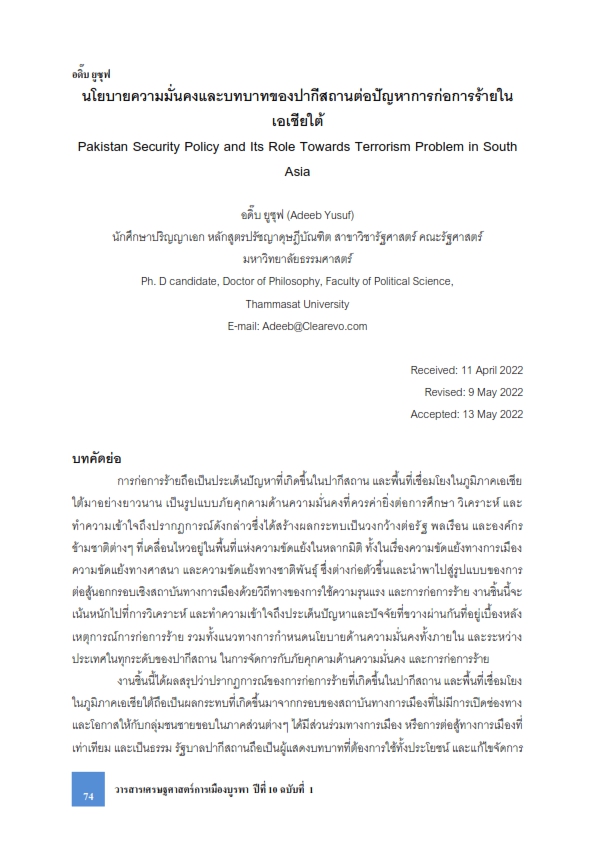Pakistan Security Policy and Its Role Towards Terrorism Problem in South Asia
Keywords:
Security Policy, Terrorism, Threat Assessment, PakistanAbstract
Terrorism in Pakistan and the interconnected areas in South Asia is a serious issue with a long historical timeline. As a theater of terror, the Pakistani theater offers a good ground for studying, analyzing, and understanding conflict studies related issues concerning security and its far-reaching effects on the states, civilians, and the multinational organizations through a multidimensional conflict area. Political conflict, religious conflict, and ethnic conflict have framed and led to a form of contentious politics out of the political-institutional framework through violence and terrorism. This article focuses on analyzing and understanding the intersecting factors behind terrorist incidents in Pakistan and various interconnected areas in South Asia. Pakistan’s policy concerns internal and international security at different levels and how it addresses the threats to security and terrorism.
The article deduces that the phenomenon of terrorism occurring in Pakistan and its interconnected areas of South Asia are the results of the intra-state political framework which does not offer opportunities and prospects for the marginalized citizens to participate equally in politics to express their demands and for equal and fair participation. The government of Pakistan wants to both utilize and solve the problems of the rise of terrorism in constructive ways that depend on the context of the situation, which will be beneficial. As an actor who interacts or engages behind the scenes of terrorism or as one who suppresses the terrorism through different mechanisms, in addition, those acts are consistent with the threat assessment based on the neo-classical Realist model.
References
รายการอ้างอิง
Books
Coll, Steve. (2004) Ghost Wars The Secret History of the CIA, Afghanistan, and Bin Laden, from the Soviet Invasion to September 10,
New York: Penguin Press.
Cooley, J. K. (2001). Unholy Wars Afghanistan, America and International Terrorism. London:
Pluto Press.
Eamon, M. (2014). The Making of Terrorism in Pakistan: Historical and Social Roots of
Extremism. London: Routledge.
Hill C. P., & Bilge, S. (2021). Intersectionality. Medford, MA: Polity Press.
Hinnells, J. R., & King, R. (2007). Religion and Violence in South Asia Theory and Practice. Abingdon: Routledge.
Jaffrelot, C. (2002). Pakistan: Nationalism Without a Nation?. New Delhi: Manohar.
Lobell, E. S., Norrin, M. R., Taliaferro, J. W. (2009). Neoclassical Realism, the State, and
Foreign Policy. Cambridge: Cambridge University Press.
Mitrany, D. (1975). The Functional Theory of Politics. London: London School of Economics & Political Science.
Mitrany, D. (1994). A Working Peace System. In Nelsen, B.F., Stubb, A.CG. (eds) The European
Union. London: Palgrave.
Musharraf, P. (2006). In the Line of Fire: A Memoir. New York: Free Press.
Ramachandra, G. (2019). India After Gandhi: The History of the World's Largest Democracy. New York: Ecco Press.
Ṣiddīqī, Abdurraḥmān. (2004). East Pakistan the End Game: An Onlooker's Journal 1969-1971.
Karachi: Oxford University Press.
Talbot, I. (2012). Pakistan: A Modern History. London: Hurst.
Tilly, C., & Tarrow, S. G. (2015). Contentious Politics. New York: Oxford University Press.
Articles
Ali Shah, M. S. (2007). Pakistan and the War against Terrorism. Pakistan Horizon, 60(2), 85-107.
Hussain, T. (2005). US-Pakistan engagement: The war on terrorism and beyond. United States
Institute of Peace, Special Report (145), 3-24.
Javaid, Umbreen, J., & Jahangir, A. (2017). Pakistan-China Strategic Relationship: A Glorious
Journey of 55 Years. Journal of the Research Society of Pakistan, 52, 157-181.
Khan, R. A. (2012). Pakistan and China: Cooperation in Counter-terrorism. Strategic Studies, Vol.
/33, 70-78.
Muhammad, Q. (1998). Sectarianism in Pakistan: The Radicalization of Shi’i and Sunni Identities.
Modern Asian Studies, 32(3), 689-716.
Sidky, H. (2007). War, Changing Patterns of Warfare, State Collapse, and Transnational Violence in Afghanistan: 1978-2001. Modern Asian Studies, 41(4), 849-888.
Electronic, Media
Declan, W. (2011). Blasts in Pakistan Kill Scores and Stir Fears on Elections, The New York Times. Retrieved August 15, 2021, from https://www.nytimes.com/2013/01/11/ world/asia/pakistan-blast-quetta-swat-valley-elections.html
Kakar, H. (2021). Pakistan’s ‘Good’ and ‘Bad’ Terrorists. Retrieved March 27, 2021, from https://www.orfonline.org/expert-speak/pakistan-good-bad-terrorists/
Kronstadt, A. K. (2015). Pakistan-U.S. Relations: Issues for the 114th Congress, 2015 CRS Reports. Retrieved June 25, 2022, from https://sgp.fas.org/crs/row/R44034.pdf
Majeed, Z. (2021). US In Touch with India For 'over-the-horizon' Strategy To Counter Terrorism In Afghanistan. Republicworld. Retrieved September 5, 2021, from https://www.republicworld.com/world-news/us-news/us-in-touch-with-india-for-over- the-horizon-strategy-to-counter-terrorism-in-afghanistan.html
Shamil, S. (2019). Belt and Road Forum: Is the China-Pakistan Economic Corridor failing?, DW. Retrieved May 5, 2022, from https://www.dw.com/en/belt-and-road-forum-is-the-china- pakistan-economic-corridor-failing/a-48473486
The Guardian. (2011). Osama bin Laden killing prompts US-Pakistan war of words. Retrieved July 25, 2021, from https://www.theguardian.com/world/2011/may/04/osama-bin- laden-pakistan-us
UN. (1996). Ad Hoc Committee established by General Assembly resolution 51/210 of 17 December 1996. Legal. UN. Retrieved March 2, 2022, from https://legal.un.org/ committees/terrorism/



